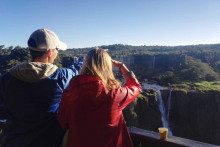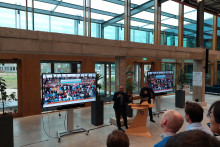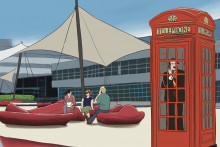It’s me again, Lennart, with a lot of impressions here in the city of Curitiba during my first two weeks. I know a lot of you will start again in a bit and hopefully enjoyed every single second of the summer holidays.
I however am here to work and to study, I do not really yet have the urge feeling to tell you about my Monday to Friday (or at least I got other things to tell, which I consider much more interesting right now).
What is the best time of the week? Exactly, the weekends. And I had two weekends, which were packed with activities and impressions. After my first week and when I finally had my jetlag under control (partying definitely helps), we made big plans for my first ‘real’ weekend here in Brazil.
50 kilometres in 3 hours
Normally, train rides are not very common in Brazil and there are only a few train rides available for personal transport. Luckily, there is one train departing from Curitiba to Morretes. The distance between these two places is only 50 kilometres, but the train took almost three hours. It is a huge tourist attraction due to the beautiful scenery. While in the train you go down from 900 meters (Curitiba’s elevation) to 10 meters (Morretes elevation) and at the same time it gets seven to nine degrees warmer. At the same time it was just amazing how the entire vegetation changed after one tunnel and has turned to enormously green mountains, valleys and rivers. The national park we crossed is called ‘serra verde’ (green mountain range) and I think I know why. After this nice experience, we enjoyed our time in the little village Morretes, which was a nice calm-down compared to the metropolis Curitiba.
Let’s jump to the next weekend and there we even took an airplane for an one-hour flight to see something I have never seen before. In the far west of Paraná (Curitiba is it’s capital) is a town called Foz do Iguaçu. This town is located right at the borders to Argentina and Paraguay. The natural border between Argentina and Brazil is formed by the Iguazú River, which has beautiful waterfalls on both sides from the border.
I had no idea because I did not look up any pictures before our trip. Luckily I did not! At first we visited the national park from the Brazilian side and it was just amazing. There were countless waterfalls and every single one was somehow trying to be better than the other one. I hope I can transfer this crazy feeling that you have with the pictures I took.

On the next day, we still couldn’t get enough and decided to visit the Argentinian side of the river. We converted money and briefly immigrated to Argentina, which worked all fine (and gave me a new stamp in my passport). Here the area that tourists could visit was even bigger with once again many, many waterfalls. The entire park roughly has 280 of water-masses falling down into the Iguazú River.

The Brazilian side of the waterfalls is not only the second biggest tourist attraction of the country (after Rio de Janeiro obviously). It is also the second biggest water power plant in the world and roughly produces 15% of Brazil’s energy consumption (just a number: Brazil has 210 million inhabitants) and at the same time it also produces 86% of the consumed energy in Paraguay. I would say those waterfalls are a real blessing for all countries around it.
I am definitely looking forward to more weekends like these! And of course I will also tell you soon about my work that I am doing here, so stay tuned and hope you enjoy these little stories from the south of Brazil.
Until next time,
Lennart








